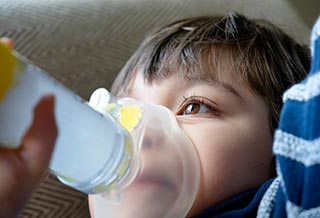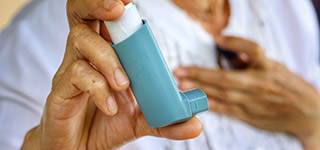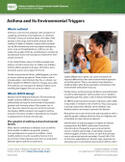Introduction

Asthma
Asthma is a chronic lung disease with symptoms of coughing, wheezing, chest tightness, or shortness of breath. During an asthma attack, the sides of the airways in lungs swell and the airways shrink, making it harder to breathe. Severe asthma attacks can be life-threatening and may require emergency room visits and hospitalizations.
Asthma can reduce quality of life by contributing to emotional and physical stress and may lead to missed time from school and work.
In the United States, more than 25 million people have asthma, of which 4.7 million are children. Asthma affects people of all ages, ethnicities, races, and sexes across every region of the U.S.1
Family history and environmental factors have been linked to asthma development. Certain factors, called triggers, can start or worsen asthma symptoms. These factors include pollen, viral infections like flu, or cold air. Triggers can be different for different people.2
Asthma can be managed by taking medicine and avoiding the environmental triggers that can cause an attack.
The National Heart, Lung, and Blood Institute of NIH issued the "2020 Focused Updates to the Asthma Management Guidelines: A Report from The National Asthma Education and Prevention Program Expert Panel Working Group". Report recommendations are designed to improve the care of people living with asthma and help primary care providers and specialists make informed decisions about asthma management. Asthma management guidance is provided for six areas:

- Using inhaled corticosteroids when needed for recurrent wheezing or persistent asthma.
- Using long-acting antimuscarinic agents (LAMAs) with inhaled corticosteroids for long-term asthma management. A LAMA is a bronchodilator, a medicine that helps keep airway muscles relaxed.
- Using allergy shots that contain small amounts of allergen to treat some people with allergic asthma.
- Using methods to reduce exposure to indoor asthma triggers.
- Using a fractional exhaled nitric oxide test to help manage asthma or confirm a diagnosis. Nitric oxide can increase when there is airway inflammation.
- Using bronchial thermoplasty to treat selected adults with persistent asthma. During this procedure heat is used to reduce muscle around the airways.
-
CDC (U.S. Centers for Disease Control and Prevention). 2018. Most recent national asthma data. [accessed April 17, 2019]. [Available CDC (U.S. Centers for Disease Control and Prevention). 2018. Most recent national asthma data. [accessed April 17, 2019].]
-
Salo PM, Wilderson J, Rose KM, Cohn RD, Calatroni A, Mitchell HE, Server ML, Gergen PJ, Thorne PS, Zeldin DC. 2018. Bedroom allergen exposures in US households. J Allergy Clin Immunol 141(5):1870-1879. [Abstract Salo PM, Wilderson J, Rose KM, Cohn RD, Calatroni A, Mitchell HE, Server ML, Gergen PJ, Thorne PS, Zeldin DC. 2018. Bedroom allergen exposures in US households. J Allergy Clin Immunol 141(5):1870-1879.]
What is NIEHS Doing?
NIEHS conducts and supports asthma research from basic studies in laboratories to human clinical trials. This research focuses on complex relationships among the environment and people’s genetics and immune system.
Indoor triggers of asthma – Indoor air quality is a major concern for lung health. Dust mites, pests such as cockroaches and rodents, pet dander, molds, and fungi are common indoor triggers for asthma.
Healthy school environments can be important for reducing asthma risk in children. A study of inner-city students linked airborne mouse allergens in schools to increased asthma symptoms and decreased lung function in children.3 This study suggests schools can take steps to improve air quality and help children who have asthma.
NIEHS-funded research has shown that inner-city children with obesity who live in homes with high levels of indoor air pollution may have worse asthma symptoms if they are also deficient in vitamin D.4
Researchers at NIEHS discovered that frequent wood burning at home is linked to decreased lung function in adults with asthma. In rural, colder parts of the U.S., wood is often burned indoors to supplement heating. Individuals with asthma should consider reducing indoor wood burning or adding air filtration devices, according to the scientists.
Outside triggers of asthma – NIEHS-funded researchers found babies who breathe high levels of traffic-related air pollution were more likely to have persistent wheezing during childhood, and children exposed to high levels of traffic-related air pollution through age 7 were more likely to develop asthma.5 Another NIEHS-funded study found that adolescents exposed to nitrogen dioxide, an indicator of traffic-related pollution, experienced shifts in hormone levels that affect their response to stress, suggesting a way that air pollution might make asthma worse.6
Adding to evidence linking outdoor air pollution and childhood asthma development, researchers partially funded by NIEHS found exposure to PM2.5 and nitrogen dioxide in the first three years of life was associated with more cases of asthma in early and middle childhood.
A NIEHS-funded study was the first to link reduced emissions from coal-powered plants with health benefits. Asthma symptoms and asthma hospitalizations dropped dramatically in response to reduced power plant emissions, according to the study. The researchers took advantage of a natural experiment in Louisville, Kentucky, between 2013 and 2016. During that time, nearby power plants either stopped using coal as the energy source or installed better emission controls.
NIEHS-funded researchers analyzed five years of data from New York City’s Clean Fuel Bus Program and found that the program led to significant reductions in concentrations of air pollutants that can contribute to asthma.
The genetics of asthma – Asthma often runs in families, which suggests that genetics plays a role in disease development. NIEHS researchers have shown that asthma patients with a specific genetic makeup who live close to a highway are more likely to have intense symptoms.8 Another NIEHS study found that certain indicators within DNA may predict a newborn’s risk of asthma.9 This information may help researchers identify which children may develop asthma and how to develop a treatment for preventing the disease.
Asthma and the immune system – The immune system, our body’s defense against infection, has a complex role in the development of asthma. A NIEHS-funded study showed that children who live on traditional Amish farms, which use animals rather than machines, were less likely to have asthma. The researchers suggest that the rich microbial environment on Amish farms may help build a stronger immune response in those children.10
Although exposure to some bacteria and similar microbes can benefit the immune system, exposure to others can be harmful. Scientists funded by NIEHS showed that children who were exposed to high levels of molds were more likely to have asthma at age 7.11
Asthma and occupational exposure – NIEHS grant recipients conducted a study in mice that simulated agricultural dust exposures. They uncovered a novel role for the protein IL-22 in lung repair, and this finding could aid development of therapeutics for farmworkers and others experiencing environmentally induced lung diseases, such as asthma.
Following the 2010 Deepwater Horizon disaster, oil spill cleanup workers — many of whom were exposed to airborne contaminants, such as petroleum hydrocarbons — experienced increased risk of asthma, according to NIEHS researchers who analyzed data from nearly 25,000 cleanup workers. The data revealed that cleanup workers had a greater chance of developing asthma in the three years following the oil spill compared with nonworkers.
-
Sheehan WJ, Permaul P, Petty CR, Coull BA, Baxi SN, Gaffin JM, Lai PS, Gold DR, Phipatanakul W. 2017. Association between allergen exposure in inner-city schools and asthma morbidity among students. JAMA Pediatr 171(1):31â38. [Abstract Sheehan WJ, Permaul P, Petty CR, Coull BA, Baxi SN, Gaffin JM, Lai PS, Gold DR, Phipatanakul W. 2017. Association between allergen exposure in inner-city schools and asthma morbidity among students. JAMA Pediatr 171(1):31â38.]
-
Bose S, Diette GB, Woo H, Koehler K, Romero K, Rule A, Detrick B, Brigham E, McCormack M, Hansel NN. 2019. Vitamin D status modifies the response to indoor particulate matter in obese urban children with asthma. J Allergy Clin Immunol Pract; doi: https://doi.org/10.1016/j.jaip.2019.01.051 [Online 11 February 2019]. [Abstract Bose S, Diette GB, Woo H, Koehler K, Romero K, Rule A, Detrick B, Brigham E, McCormack M, Hansel NN. 2019. Vitamin D status modifies the response to indoor particulate matter in obese urban children with asthma. J Allergy Clin Immunol Pract; doi: https://doi.org/10.1016/j.jaip.2019.01.051 [Online 11 February 2019].]
-
Brunst KJ, Ryan PH, Brokamp C, Bernstein D, Reponen T, Lockey J, Khurana Hershey GK, Levin L, Grinshpun SA, LeMasters G. 2015.Timing and duration of traffic-related air pollution exposure and the risk for childhood wheeze and asthma. Am J Respir Crit Care Med 192(4):421-7. [Abstract Brunst KJ, Ryan PH, Brokamp C, Bernstein D, Reponen T, Lockey J, Khurana Hershey GK, Levin L, Grinshpun SA, LeMasters G. 2015.Timing and duration of traffic-related air pollution exposure and the risk for childhood wheeze and asthma. Am J Respir Crit Care Med 192(4):421-7.]
-
Wing SE, Bandoli G, Telesca D, Su JG, Ritz B. 2018. Chronic exposure to inhaled, traffic-related nitrogen dioxide and a blunted cortisol response in adolescents. Environ Res 163:201-207. [Abstract Wing SE, Bandoli G, Telesca D, Su JG, Ritz B. 2018. Chronic exposure to inhaled, traffic-related nitrogen dioxide and a blunted cortisol response in adolescents. Environ Res 163:201-207.]
-
Schurman SH, Bravo MA, Innes CL, Jackson WB 2nd, McGrath JA, Miranda ML, Garantziotis S. 2018. Toll-like receptor 4 pathway polymorphisms interact with pollution to influence asthma diagnosis and severity. Sci Rep 8(1):12713. [Abstract Schurman SH, Bravo MA, Innes CL, Jackson WB 2nd, McGrath JA, Miranda ML, Garantziotis S. 2018. Toll-like receptor 4 pathway polymorphisms interact with pollution to influence asthma diagnosis and severity. Sci Rep 8(1):12713.]
-
Reese SE, Xu CJ, den Dekker HT, Lee MK, Sikdar S, Ruiz-Arenas C, Merid SK, Rezwan FI, Page CM, Ullemar V, Melton PE, Oh SS, Yang IV, Burrows K, Soderhall C, Jima DD, Gao L, Arathimos R, Kuppers LK, Wielscher M, Rzehak P, Lahti J, Laprise C, Madore AM, Ward J, Bennett BD, Wang T, Bell DA, BIOS consortium, Vonk JM, Haberg SE, Zhao S, Karlsson R, Hollams E, Hu D, Richards AJ, Bergstrom A, Sharp GC, Felix JF, Bustamante M, Gruzieva O, Maguire RL, Gilliland F, Baiz N, Nohr EA, Corpeleijn E, Sebert S, Karmaus W, Grote V, Kajantie E, Magnus MC, Ortqvist AK, Eng C, Liu AH, Kull I, Jaddoe VWV, Sunyer J, Kere J, Hoyo C, Annesi-Maesano I, Arshad SH, Koletzko B, Brunekreef B, Binder EB, Raikkonen K, Reischl E, Holloway JW, Jarvelin MR, Snieder H, Kazmi N, Breton CV, Murphy SK, Pershagen G, Anto JM, Relton CL, Schwartz DA, Burchard EG, Huang RC, Nystad W, Almqvist C, Henderson AJ, Melen E, Duijts L, Koppelman GH, London SJ. 2018. Epigenome-wide meta-analysis of DNA methylation and childhood asthma. Journal of Allergy and Clinical Immunology 143(6):2062-2074. [Abstract Reese SE, Xu CJ, den Dekker HT, Lee MK, Sikdar S, Ruiz-Arenas C, Merid SK, Rezwan FI, Page CM, Ullemar V, Melton PE, Oh SS, Yang IV, Burrows K, Soderhall C, Jima DD, Gao L, Arathimos R, Kuppers LK, Wielscher M, Rzehak P, Lahti J, Laprise C, Madore AM, Ward J, Bennett BD, Wang T, Bell DA, BIOS consortium, Vonk JM, Haberg SE, Zhao S, Karlsson R, Hollams E, Hu D, Richards AJ, Bergstrom A, Sharp GC, Felix JF, Bustamante M, Gruzieva O, Maguire RL, Gilliland F, Baiz N, Nohr EA, Corpeleijn E, Sebert S, Karmaus W, Grote V, Kajantie E, Magnus MC, Ortqvist AK, Eng C, Liu AH, Kull I, Jaddoe VWV, Sunyer J, Kere J, Hoyo C, Annesi-Maesano I, Arshad SH, Koletzko B, Brunekreef B, Binder EB, Raikkonen K, Reischl E, Holloway JW, Jarvelin MR, Snieder H, Kazmi N, Breton CV, Murphy SK, Pershagen G, Anto JM, Relton CL, Schwartz DA, Burchard EG, Huang RC, Nystad W, Almqvist C, Henderson AJ, Melen E, Duijts L, Koppelman GH, London SJ. 2018. Epigenome-wide meta-analysis of DNA methylation and childhood asthma. Journal of Allergy and Clinical Immunology 143(6):2062-2074.]
-
Stein MM, Hrusch CL, Gozdz J, Igartua C, Pivniouk V, Murray SE, Ledford JG, Marques dos Santos M, Anderson RL, Metwali N, Neilson JW, Maier RM, Gilbert JA, Holbreich M, Thorne PS, Martinez FD, von Mutius E, Vercelli D, Ober C, Sperling AI. 2016. Innate immunity and asthma risk in Amish and Hutterite farm children. N Engl J Med 375(5):411â421. [Abstract Stein MM, Hrusch CL, Gozdz J, Igartua C, Pivniouk V, Murray SE, Ledford JG, Marques dos Santos M, Anderson RL, Metwali N, Neilson JW, Maier RM, Gilbert JA, Holbreich M, Thorne PS, Martinez FD, von Mutius E, Vercelli D, Ober C, Sperling AI. 2016. Innate immunity and asthma risk in Amish and Hutterite farm children. N Engl J Med 375(5):411â421.]
-
Zhang Z, Biagini Myers JM, Brandt EB, Ryan PH, Lindsey M, Mintz-Cole RA, Reponen T, Vesper SJ, Forde F, Ruff B, Bass SA, LeMasters G, Bernstein DI, Lockey J, Budelsky AL, Khurana Hershey GK. 2017. Beta-glucan exacerbates allergic asthma independent of fungal sensitization and promotes steroid-resistant TH2/TH17 responses. J Allergy Clin Immunol. 139(1):54-65. [Abstract Zhang Z, Biagini Myers JM, Brandt EB, Ryan PH, Lindsey M, Mintz-Cole RA, Reponen T, Vesper SJ, Forde F, Ruff B, Bass SA, LeMasters G, Bernstein DI, Lockey J, Budelsky AL, Khurana Hershey GK. 2017. Beta-glucan exacerbates allergic asthma independent of fungal sensitization and promotes steroid-resistant TH2/TH17 responses. J Allergy Clin Immunol. 139(1):54-65.]
Further Reading
Stories from the Environmental Factor (NIEHS Newsletter)
- How Does the Environment Affect Asthma? (May 2025)
- Pediatrician Shares Keys to Reducing Wildfire Smoke Exposure (May 2025)
- NIEHS-Supported Research Can Help People With Asthma Breathe Better (May 2024)
- Majority of Clinicians Do Not Frequently Assess Environmental Asthma Triggers (February 2024)
- Targeting the Root Cause of Asthma (July 2023)
- Intense Allergic Asthma Mechanism Discovered in Mice (May 2021)
Fact Sheets
Asthma and Its Environmental Triggers
Press Releases
- NIH Statement on World Asthma Day 2023 (May 2, 2023)
- Oil Spill Cleanup Workers More Likely to Have Asthma Symptoms (August 17, 2022)
Podcasts
- The Shrinking Salton Sea and Children's Health (2022) – An NIEHS-funded project aims to understand how the rapid drying of the Salton Sea will impact local air pollution and affect children’s lung health. Their community-based approach educates and empowers residents to address local environmental health issues.
Additional Resources
- From CDC, read about EXHALE, a set of six strategies that contribute to better asthma control.
- Learn How to Control Asthma – more information from CDC.
- What Is Asthma? – Information from the National Heart, Lung, and Blood Institute, part of the National Institutes of Health.
Related Health Topics
This content is available to use on your website.
Please visit NIEHS Syndication to get started.


